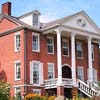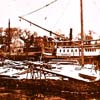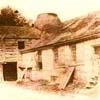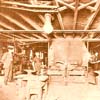facilitated the construction of turnpikes, public highways, bridges, and ferry services to improve transportation along and between the river shores 9 . A rail line built in 1866 between Athens and Schenectady turned the community into a busy shipping port in the late 1860s and early 1870s as warehouses along the town's shores stored derailed goods waiting further transportation down the Hudson. As the population grew, Athens modernized, boasting such amenities as electricity and town water by 1906. Yet Athens' days of commercial glory were short lived. By the 1880s, the Athens to Schenectady train service ended with alternate rail routes bypassing the town. The loss of a railroad coupled with the movement of markets and regional population to the West, the reduced reliance on the Erie Canal to Hudson River shipping system, and the closing of the brick and shipyards during the 1930s Depression brought Athens' days of growth to an end 10 .
Ownership - Anthony Rutgers Livingston
Anthony Rutgers Livingston (b. 1789), a shipping entrepreneur in Hudson, son of John R. Livingston (1750 - 1822), and grandson of manorial patroon, Robert Livingston III, was one of the men whom Northrup inspired to live in Athens 11 . Livingston spent his earliest life at Oak Hill, his father's estate in Columbia County. In 1818, Livingston married Anna Hoffman (1798 - 1874) and had five children by the time the couple moved to Athens in 1823 12 . On arrival in Athens, Livingston's first real estate acquisition was a 178 1/2 acre farm on the outskirts of the town which the young man obtained from his deceased father's estate 13 . Two years later, Livingston expanded his holdings, purchasing from Isaac Northrup the waterfront property on which 12 South Water Street now stands 14 . Similar to Northrup and Eugene Van Loon, two of the wealthiest men in Athens, Livingston selected the straight line classic simplicity of the Federal style to define his home. Livingston's choice of brick over wood for a building material, white marble for lintels, an imposing two story portico above his front door, and delicate interior detailing show the mercantilist's desire to appear both prominent and refined. Yet Livingston's decision to build the house in a common bond brick pattern over a more sophisticated Flemish bond or other intricate design poses an enigma. Perhaps the businessman felt that the beauty of the waterfront setting as well as expensive touches such as the marble lintels diminished the need for elaborate brickwork. Livingston may have decided to conserve money on the brick pattern to pay for an ell extension, a nontraditional Federal style feature, which gave the businessmen extra space to meet the needs of a growing family and professional interests 15 .
While residing in Athens, Livingston kept a professional and civic relationship with the community. With at least one Athens resident and businessman, Jacob Brandow, Livingston shared ownership of a trading company and a seventy-four foot long vessel, the Eclipse 16 . Livingston also acted as executor over family and local estates. In a well-publicized trial in 1829 , Livingston sued a mining company in Peru, New York for fraud on behalf of his father's business interests and lost the case 17 . A few years later, Livingston stabbed a man who
-------------------------
9.Athens: 1776 - 1976: Its People and Industry, 26-27.
10.Horne, 109, 135-136, 148.
11.The Catskill Recorder. September 20, 1935.
Van Rensselaer, Florence. The Livingston Family in America and Its Scottish Origins. (Salem: Higginson Book Company, 2000: 93-94).
Beers, 168.
12.Ibid.
13.Green County Office of Record, Deed: A. Livingston from J. Livingston estate, F pg. 328, year 1823.
14.Green County Office of Record, Deed: Livingston from Northrup, H pg. 299, year 1825.
15.The original ell-shape was determined through an analysis of the exterior brickwork (brick / mortar adjustment only evident in left rear as facing the building), assessment of the basement support beam in the ell extension (showed non-machine cutting which dated the beam to before 1835), review of a Beers’ Green County map of the house in 1867, and research of newspaper clippings which discussed renovations on the house in the 1930s.
16.Athens 1776 - 1976: Its People and Industry, 15.
17.Van Orden, Jacob. State of New York in the Court for the Trial of Impeachment & the Correction of Errors: Brief on behalf of Anthony R. Livingston, appellant vs. The Peru Iron Company. (Catskill:Messenger, 1831).










